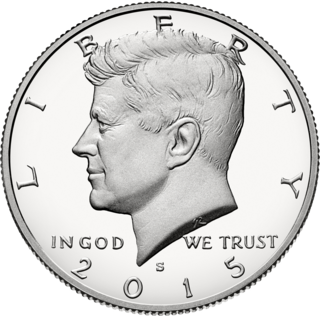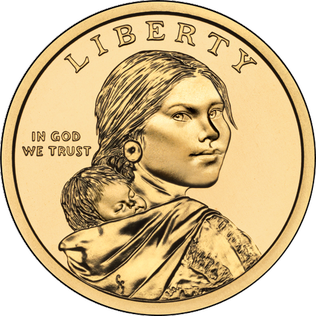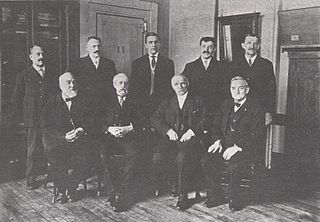Coins of the United States dollar were first minted in 1792. New coins have been produced annually since then and they make up a valuable aspect of the United States currency system. Today, circulating coins exist in denominations of 1¢, 5¢, 10¢, 25¢, 50¢, and $1.00. Also minted are bullion and commemorative coins. All of these are produced by the United States Mint. The coins are then sold to Federal Reserve Banks which in turn are responsible for putting coins into circulation and withdrawing them as demanded by the country's economy.

The British crown, the successor to the English crown and the Scottish dollar, came into being with the Union of the kingdoms of England and Scotland in 1707. As with the English coin, its value was five shillings.

A nickel, in American usage, is a five-cent coin struck by the United States Mint. Composed of 75% copper and 25% nickel, the piece has been issued since 1866. Its diameter is .835 inches and its thickness is .077 inches (1.95 mm). Due to inflation, the purchasing power of the nickel continues to drop and currently the coin represents less than 1% of the federal hourly minimum wage. In 2015, over 1.5 billion nickels were produced at the Philadelphia and Denver mints.

The dime, in United States usage, is a ten-cent coin, one tenth of a United States dollar, labeled formally as "one dime". The denomination was first authorized by the Coinage Act of 1792. The dime is the smallest in diameter and is the thinnest of all U.S. coins currently minted for circulation, being .705 inch (17.91 mm) in diameter and .053 inch (1.35 mm) in thickness. The obverse of the coin depicts the profile of President Franklin D. Roosevelt and the reverse boasts an olive branch, a torch, and an oak branch, from left to right respectively. As of 2011, the dime coin cost 5.65 cents to produce.

The half dollar, sometimes referred to as the half for short, is a United States coin worth 50 cents, or one half of a dollar, and is the largest United States circulating coin currently produced in both size and weight, being 1.205 inches (30.61 mm) in diameter and .085 inches (2.15 mm) in thickness, and is twice the weight of the quarter. The current half dollar, the Kennedy half dollar, depicts the profile of President John F. Kennedy on the obverse and the Seal of the President of the United States on the reverse, but the design has undergone a number of changes throughout its history.

The dollar coin is a United States coin worth one United States dollar. It is the second largest U.S. coin currently minted for circulation in terms of physical size, with a diameter of 1.043 inches (26.5 mm) and a thickness of .079 inches (2 mm), coming second to the half dollar. Dollar coins have been minted in the United States in gold, silver, and base metal versions. Dollar coins were first minted in the United States in 1794. The term silver dollar is often used for any large white metal coin issued by the United States with a face value of one dollar, whether or not it contains some of that metal. While true gold dollars are no longer minted, the Sacagawea and Presidential dollars are sometimes referred to as golden dollars due to their color.
Proof coinage refers to special early samples of a coin issue, historically made for checking the dies and for archival purposes, but nowadays often struck in greater numbers specially for coin collectors (numismatists). Nearly all countries have issued proof coinage.

The Eisenhower dollar is a one-dollar coin issued by the United States Mint from 1971 to 1978; it was the first coin of that denomination issued by the Mint since the Peace dollar series ended in 1935. The coin depicts President Dwight D. Eisenhower on the obverse, and a stylized image honoring the 1969 Apollo 11 Moon mission on the reverse, with both sides designed by Frank Gasparro.

The Canadian five-cent coin, commonly called a nickel, is a coin worth five cents or one-twentieth of a Canadian dollar. It was patterned on the corresponding coin in the neighbouring United States. It became the smallest-valued coin in the currency upon the discontinuation of the penny in 2013. Due to inflation, the purchasing power of the nickel continues to drop and currently the coin represents less than 0.5% of the country's lowest minimum hourly wage.

Charles Edward Barber was the sixth Chief Engraver of the United States Mint from 1879 until his death in 1917. He had a long and fruitful career in coinage, designing most of the coins produced at the mint during his time as Chief Engraver. He did full coin designs, and he designed about 30 medals in his lifetime. The Barber coinage were named after him. In addition, Barber designed a number of commemorative coins, some in partnership with Assistant Engraver George T. Morgan. For the popular Colombian half dollar, and the Panama-Pacific half dollar and quarter eagle, Barber designed the obverse and Morgan the reverse. Barber also designed the 1883 coins for the Kingdom of Hawaii, and also Cuban coinage of 1915. Barber's design on the Cuba 5 centavo coin remained in use until 1961.

In coin collecting, a key date refers to a date of a given coin series or set that is harder to obtain than other dates in the series. The next level of difficult to obtain coins in series are often referred to as semi-key dates or simply semi-keys.
The Voyageur Dollar was a coin of Canada struck for circulation from 1935 through 1986. Until 1968, the coin was composed of 80% silver. A smaller, nickel version for general circulation was struck from 1968 through 1986. In 1987, the coin was replaced by the loonie. However, like all of Canada's discontinued coins, the voyageur dollar coins remain legal tender.

The American Buffalo, also known as a gold buffalo, is a 24-karat bullion coin first offered for sale by the United States Mint on June 22, 2006, and available for shipment beginning on July 13. The coin follows the design of the Indian Head nickel and has gained its nickname from the American Bison on the reverse side of the design. This was the first time ever that the United States Government has minted pure (.9999) 24-karat gold coins for the public. The coin has a legal tender (face) value of US$50. Due to a combination of the coin's popularity and the tremendous increase in the price of gold since its creation the coin's value has increased considerably in a short time of just a few years. The initial 2006 U.S. Mint price of the proof coin was $800. In 2007 the Mint proof coin was $899.95, $1,410.00 in 2009, and $2,010.00 in 2011.

The United States Mint has minted over 20 different kinds of coins, of many different sizes. Often, it is difficult for people to get a grasp of what much of the historical coinage looked like, at least in relation to modern circulating coins. This chart shows all of the coin types, and their sizes, grouped by coins of similar size and by general composition.

The Columbian half dollar is a coin issued by the Bureau of the Mint in 1892 and 1893. The first United States commemorative coin, it was issued both to raise funds for the 1893 World's Columbian Exposition and to mark the quadricentennial of the first voyage to the Americas of Christopher Columbus, whose portrait it bears. The Columbian half dollar was the first American coin to depict a historical person.
Coins of the Australian dollar were introduced on 14 February 1966, although they did not at that time include one-dollar or two-dollar coins. The dollar was equivalent in value to 10 shillings in the former currency.
The United States has several coins and banknotes which were proposed at one time but never adopted.






















